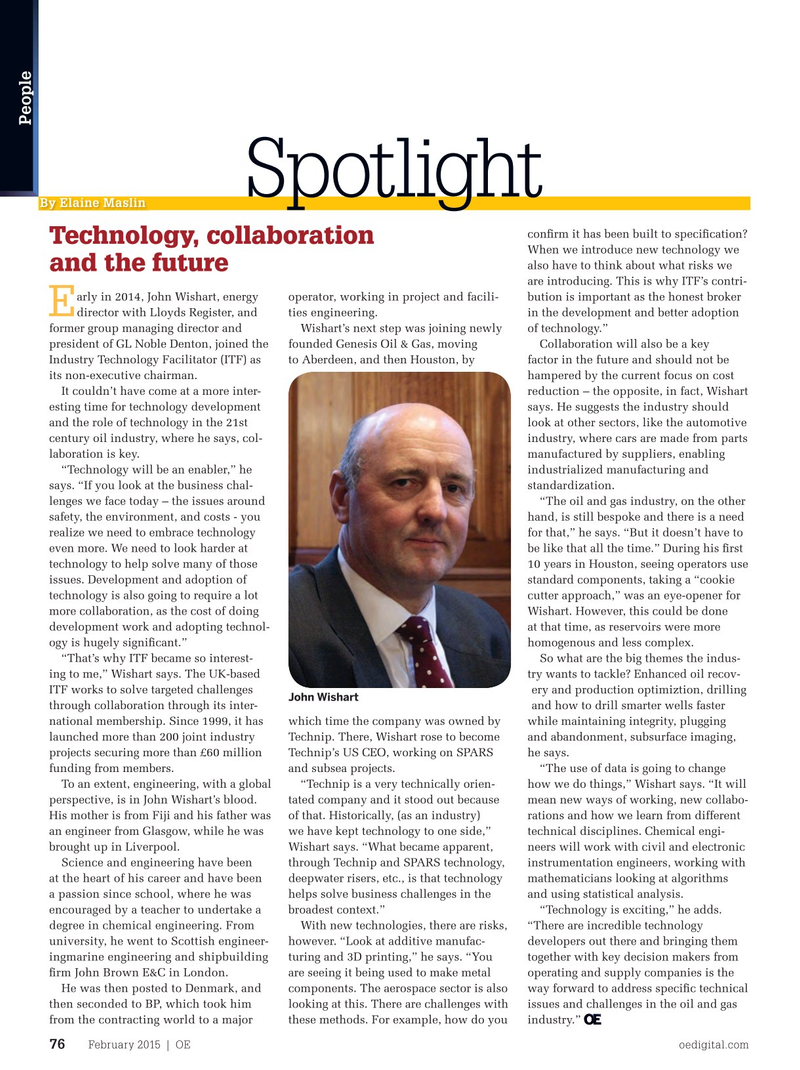
Page 74: of Offshore Engineer Magazine (Feb/Mar 2015)
Read this page in Pdf, Flash or Html5 edition of Feb/Mar 2015 Offshore Engineer Magazine
People
Spotlight
By Elaine Maslin con? rm it has been built to speci? cation?
Technology, collaboration
When we introduce new technology we also have to think about what risks we and the future are introducing. This is why ITF’s contri- arly in 2014, John Wishart, energy operator, working in project and facili- bution is important as the honest broker
E director with Lloyds Register, and ties engineering. in the development and better adoption former group managing director and Wishart’s next step was joining newly of technology.” president of GL Noble Denton, joined the founded Genesis Oil & Gas, moving Collaboration will also be a key
Industry Technology Facilitator (ITF) as to Aberdeen, and then Houston, by factor in the future and should not be its non-executive chairman. hampered by the current focus on cost
It couldn’t have come at a more inter- reduction – the opposite, in fact, Wishart esting time for technology development says. He suggests the industry should and the role of technology in the 21st look at other sectors, like the automotive century oil industry, where he says, col- industry, where cars are made from parts laboration is key. manufactured by suppliers, enabling “Technology will be an enabler,” he industrialized manufacturing and says. “If you look at the business chal- standardization.
lenges we face today – the issues around “The oil and gas industry, on the other safety, the environment, and costs - you hand, is still bespoke and there is a need realize we need to embrace technology for that,” he says. “But it doesn’t have to even more. We need to look harder at be like that all the time.” During his ? rst technology to help solve many of those 10 years in Houston, seeing operators use issues. Development and adoption of standard components, taking a “cookie technology is also going to require a lot cutter approach,” was an eye-opener for more collaboration, as the cost of doing Wishart. However, this could be done development work and adopting technol- at that time, as reservoirs were more ogy is hugely signi? cant.” homogenous and less complex. “That’s why ITF became so interest- So what are the big themes the indus- ing to me,” Wishart says. The UK-based try wants to tackle? Enhanced oil recov-
ITF works to solve targeted challenges ery and production optimiztion, drilling
John Wishart through collaboration through its inter- and how to drill smarter wells faster national membership. Since 1999, it has which time the company was owned by while maintaining integrity, plugging launched more than 200 joint industry Technip. There, Wishart rose to become and abandonment, subsurface imaging, projects securing more than £60 million Technip’s US CEO, working on SPARS he says. funding from members. and subsea projects. “The use of data is going to change
To an extent, engineering, with a global “Technip is a very technically orien- how we do things,” Wishart says. “It will perspective, is in John Wishart’s blood. tated company and it stood out because mean new ways of working, new collabo-
His mother is from Fiji and his father was of that. Historically, (as an industry) rations and how we learn from different an engineer from Glasgow, while he was we have kept technology to one side,” technical disciplines. Chemical engi- brought up in Liverpool. Wishart says. “What became apparent, neers will work with civil and electronic
Science and engineering have been through Technip and SPARS technology, instrumentation engineers, working with at the heart of his career and have been deepwater risers, etc., is that technology mathematicians looking at algorithms a passion since school, where he was helps solve business challenges in the and using statistical analysis.
encouraged by a teacher to undertake a broadest context.” “Technology is exciting,” he adds. degree in chemical engineering. From With new technologies, there are risks, “There are incredible technology university, he went to Scottish engineer- however. “Look at additive manufac- developers out there and bringing them ingmarine engineering and shipbuilding turing and 3D printing,” he says. “You together with key decision makers from ? rm John Brown E&C in London. are seeing it being used to make metal operating and supply companies is the
He was then posted to Denmark, and components. The aerospace sector is also way forward to address speci? c technical then seconded to BP, which took him looking at this. There are challenges with issues and challenges in the oil and gas from the contracting world to a major these methods. For example, how do you industry.”
February 2015 | OE oedigital.com 76 076_OE0215_Spotlight.indd 76 1/20/15 6:53 PM

 73
73

 75
75